- Step 1: Brainstorm some ideas
- Step 2: Develop your idea
- Step 3: Make a list of main characters
- Step 4: Develop a horrific setting
- Step 5: Outline the opening paragraph
- Step 6: Plan the major climax
- Step 7: Write a twisted ending
- Step 8: Choose a scary writing style
- Step 9: Write the first draft
- Step 10: Edit and review your draft
- Step 11: Choose a chilling book title
- Step 12: Publish the book
- How do you start a horror story?
- What are the 5 elements of a horror story?
- What makes a good horror story?
- How do you write in creepy writing?
- How do I make my character terrifying?
10 Tips for Writing Horror Stories
Before you begin writing a horror story, here are 8 tips to help you create the perfect, chilling tale:
- Make it realistic: Don’t be afraid to make the story feel real and genuine so that the reader doesn‘t get lost in the atmosphere of the book. Try to use real-life situations as the base of the story, and then you can add the gore afterwards.
- Include plot twists: The more twists you can add to the tale, and the more surprises that will occur, the stronger the plot.
- Avoid stereotypical characters: Just because it’s horror doesn’t mean you have to have a serial or a cannibal in your story. Go beyond the norm with your characters – remember anyone can be a serial killer, especially the least suspected person!
- Pace yourself: Don’t just jump to the scariest moment in the beginning, slowly build up the suspense. Start by giving the reader hints of danger, and then bang when they least suspect bring in the gore.
- Play on common fears: Common fears that people face every day. Such as being alone in the dark, being chased by a monster, having a bad dream, etc. Fears are icky, but they can be made into something interesting if you play with them.
- Choose a writing style: There are many ways to write horror and some people find that they have an easier time in a journalistic style or in 1st person narrative. Think about what you’re most comfortable with and try it out.
- Increase the stakes: The best horror stories involve a sense of fear and dread, so make sure to increase the stakes as you go. If your main character is at a party, maybe there’s something bad lurking in the back room or someone is trying to kill them. Make sure there’s something at stake for your characters and don’t forget to give them something to do besides running away.
- Read popular horror stories: Horror can be a very dark genre, so you might want to check out other scary tales to get inspiration. For instance, Stephen King has written some of the most terrifying stories ever created and you might even learn a few things from them.
- Pick a horror sub-genre: Horror is very broad and can be done in many different styles and genres. I recommend going for a sub-genre like Gothic Horror, Zombie Horror, or Psychological Horror. You may find that you are more comfortable in one of these areas than in others.
- Be imaginative: Your story should be as unique as possible so use your imagination and go crazy! Do not hold back when it comes to creativity, as this is how true horror is born.
How To Write a Horror Story in 12 Steps
Follow these 12 easy steps to create a spine-chilling story that will leave your readers in awe and fear.
Step 1: Brainstorm some ideas
Here’s a simple little trick that we can’t recommend enough: start with writing down all of the words and phrases that come to mind when you think about horror. Horror is much more than just scary stories; it’s about fear. So start thinking about the horror you see around you, and what keeps you up at night. The trick is to get into your mind, even if it doesn’t feel comfortable. Try listing your biggest fears, and all the things that make you feel scared. You can also check out this list of over 110 horror story prompts to get you started.
We also recommend keeping a nightmare journal – Which is like a dream journal but filled with notes about your nightmares instead. After you had a really scary dream write down everything you remember from that dream. This can include what you saw, heard and felt during the dream. You can then use these notes as a source of inspiration for your horror story.
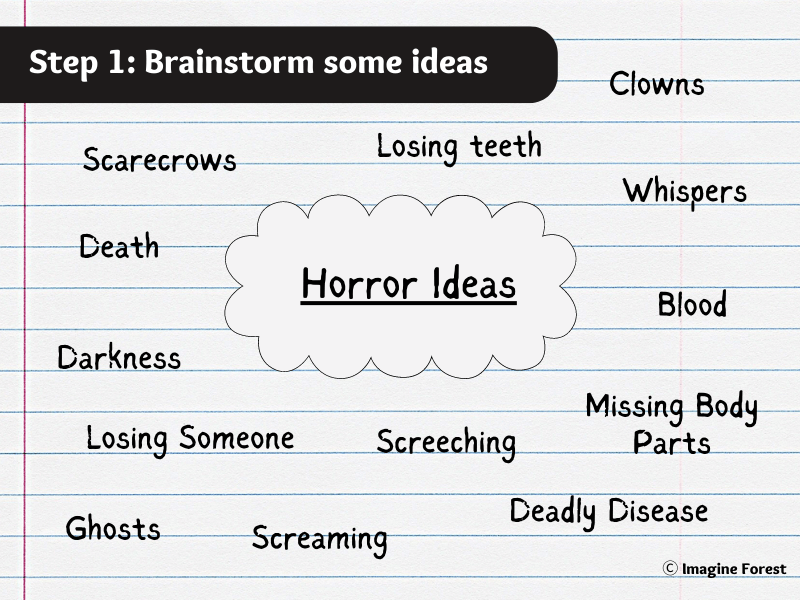
Step 2: Develop your idea
What keeps you up at night? The evil monsters in the monsters movies? The epidemic of a deadly virus? A tragic unsolved crime? Whatever your issue is, it can be used to create a horror story that will have your readers sweating bullets. Take your ideas from the previous step and develop them into a truly horrific story idea. Once you have written down the basic idea, try to think about how that idea can be made scarier.
For example, if you’re writing about a deadly disease, you could use the theme of death to make it scarier. Have the characters die in the story in a mutated sort of way or from some weird side effect that leads to death. There are plenty of ways to make the story more horrible:
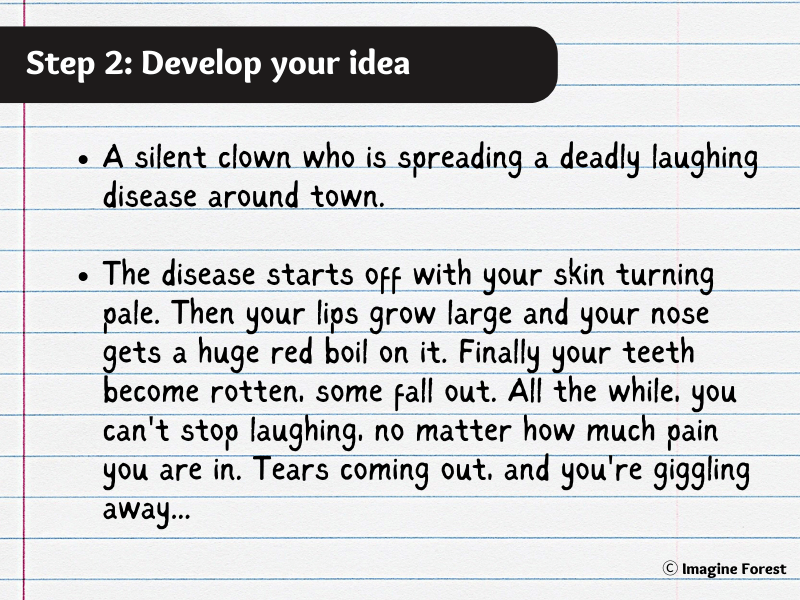
- Try thinking about an ordinary situation that everyone goes through and add something horrific to it. The trick to making your story scary is to make it believable. In other words, you want to make your story as true to life as possible.
- Focus on some terrifying emotions, fear being the obvious one. But you can also think about crudeness, disgust, as well as anger, regret, paranoia and shock factor.
- Add in some unnatural details, such as spaghetti turning into worms or blood coming out of solid, unliving objects.
Step 3: Make a list of main characters
Write down all of the main characters in the story. If you have more than one, give each character a distinct personality. Make sure that each character has a certain reason for their actions and be sure that they reflect their personality.
Whatever your horror is, you should probably have a main character that will be a part of the story. When you write the story, it’s going to be easier to create a tense atmosphere if you have a character to relate to. Also, you may want to make sure that you have a few supporting characters that you can add to the story. The supporting characters might also become the main characters in any sequels you plan on writing.
The other characters in the story should be the antagonists. These are the evil people or creatures that are keeping you up at night. They might be the killer, the ghost, the werewolf, the zombie, the villain, the monster, the demon, or the bad guy. Whatever the issue is, that’s what the antagonist will be in the story. They might start out as just an ordinary person, but they’ll end up being more evil than the main character.
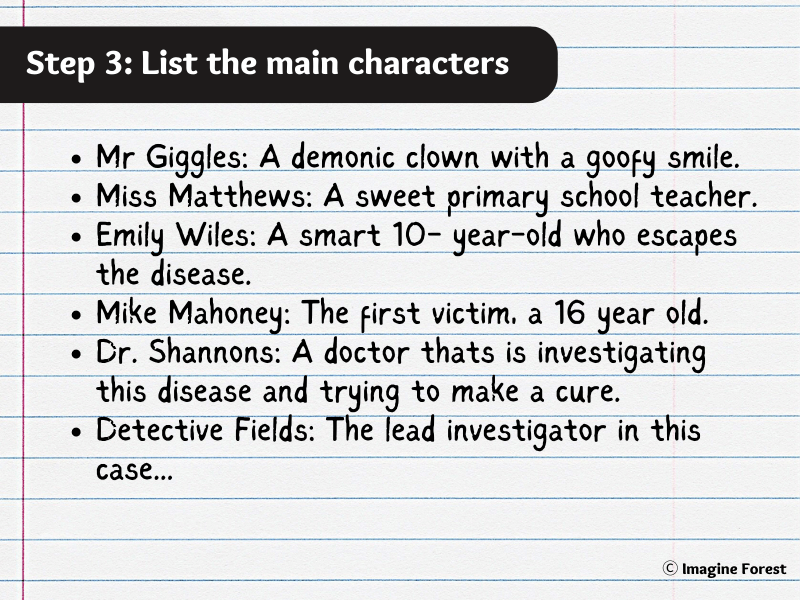
Check out this guide on character development to help you develop a powerful character.
Step 4: Develop a horrific setting
When writing a horror story, it’s very important that you get the setting right. Think about some scary places that you know of in real life or places that you’ve seen in your nightmares. You could also link your main setting choice to a common fear explored in your story. For example, if the core concept of your horror story is related to the fear of heights, then the main setting may be a high-rise building that’s filled with monsters.
Other common horror story settings may include a haunted house, a creepy old mansion, graveyards and even quiet suburban towns. Whatever your choice of setting, try to write a detailed description of the main setting in this step. Think about the appearance of the location, the weather, the feeling someone has when standing in this location, as well as what kind of people live here, along with the beliefs they hold.
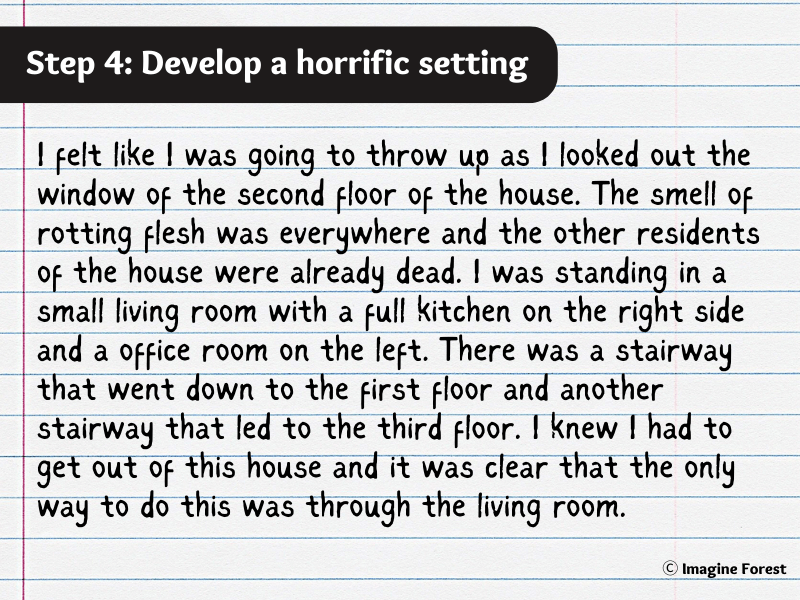
Interested in creating a whole new world for your horror story? Check this master list of over 100 world-building questions.
Step 5: Outline the opening paragraph
The opening paragraph will be the first thing your readers see. It should be a teaser that sets the tone for the story. In other words, the first paragraph should be intriguing enough to make your readers want to keep reading. You should ideally include the main character’s name, the setting, the antagonist, the fear of the story, and the main character’s problem.
If the story is about a haunted house, then the outline of the opening paragraph could say something like this:
The house is empty. It has been for a long time. It’s been vacant for years and years. It sits in the middle of a quiet, suburban neighbourhood. The grass is green and the trees are tall. The neighbourhood is quiet, but the town is not as quiet as everyone thinks. There are whispers, rumours, and stories. But the truth is, no one has ever seen or heard anything unusual here. Not until Wendy Williams and her daughter moved in.
During this step, it is important to try to write an opening that gives the reader a taste of the entire story. But of course, don’t give too much away – Just a hint of fear will do! Your goal here is to have the reader wanting more.
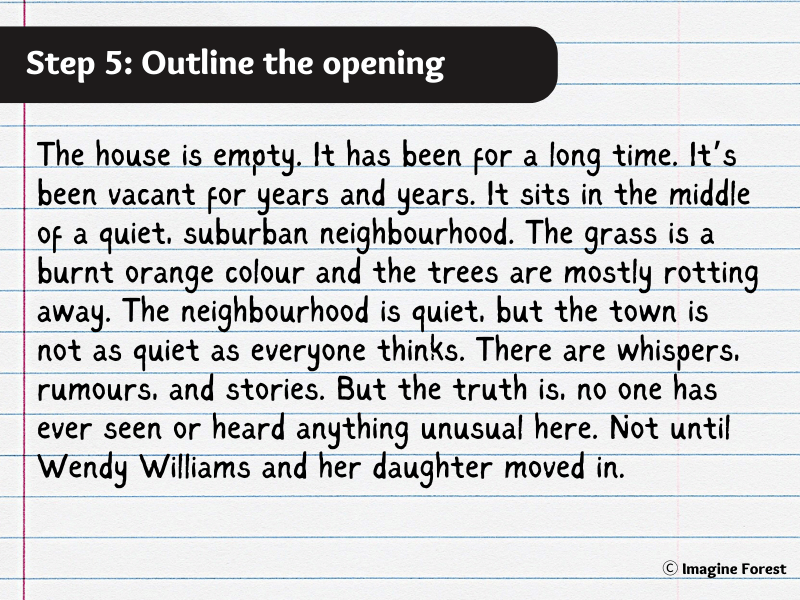
See this list of over 150 story starters to help you get started with your spooky tale.
Step 6: Plan the major climax
This step is basically the big bang. It’s where your main character goes head-to-head with the antagonist in the story or has to face their greatest fear. It’s also when your main character learns the truth about the antagonist. The goal of this step is to keep your readers on the edge of their seats.
When writing the climax, think about what will happen, who will be in danger, and what the outcome will be. If you’re struggling with the climax, then you should start with a smaller problem and work your way up to the big one. For example, you could start with a little bit of trouble with a character, such as a bad dream or the main character getting hurt. This will get your readers involved in the story. You may find that once you start writing, you’ll come up with a more complicated problem that your main character will have to solve.
Here’s an example of what a potential climax scene sounds like in a horror story:
The sound of footsteps is heard coming down the stairs. The footsteps are too heavy, and they seem to be coming from the basement. The door to the basement creaks open. Then a face is seen in the door frame. It’s a face with large, red eyes, and it’s full of hate.
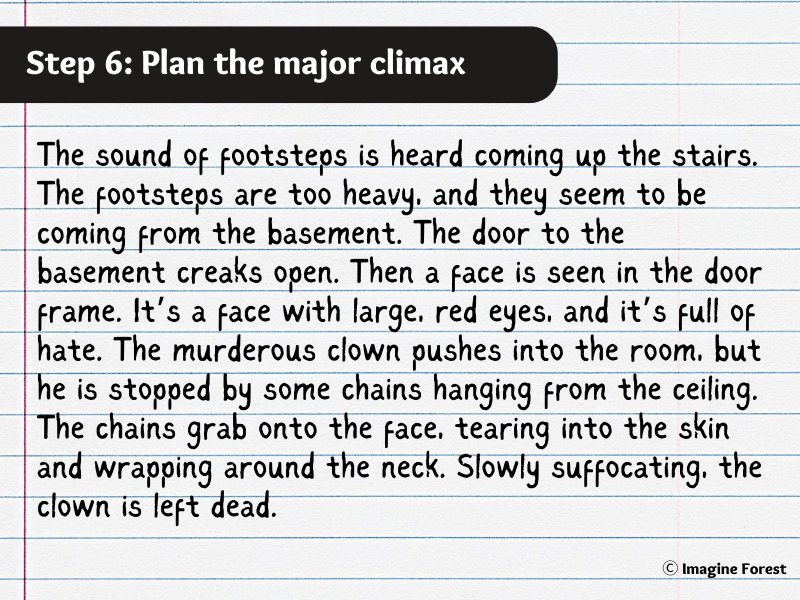
Step 7: Write a twisted ending
In horror stories, the twist ending is almost always a shock reveal of some kind. Whether the true murderer is revealed, or the identity of the antagonist is revealed, it should always be a surprise.
There are several ways to write a twist ending, but you’ll probably want to start with a twist that’s a little more obvious. You could reveal who the antagonist really is, or even what the main character has been hiding. Or you could have the main character learn some shocking information that sends them in a completely different direction.
The unique thing about the horror genre is that even after the mystery or problem is solved, it’s not always 100% solved. There’s always some darkness lurking somewhere. Was he really the murderer? Maybe there’s more than one monster? Give this final hint of darkness to keep your readers second-guessing even after the book is over. Now that’s where the true horror lies!
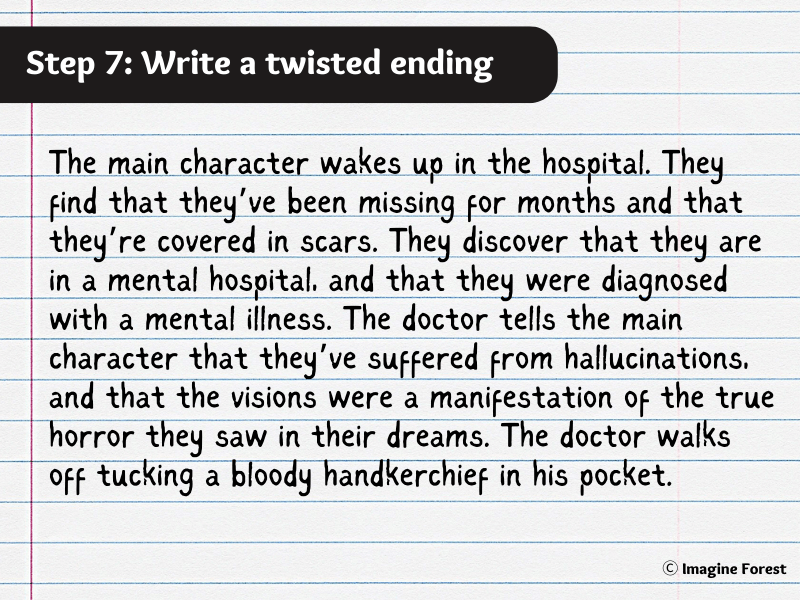
Step 8: Choose a scary writing style
Of course, horror stories are written in a more darker and dramatic style compared to other genres. But there’s more to horror writing than just using dark words and descriptions of gory scenes. In this step, you want to think about the actual writing of your horror style. Will it be written in the first person, second person or third? Do you want to take a more journalistic approach where you report horrific events? Or will you take a more narrative approach, where the reader is on the outside looking in?
In our opinion, a horror story written in the first person has a much more powerful effect. There’s something about having the perspective of the main character that makes them more vulnerable. There’s also something about being told a story by another character that makes the story more real.
While the third person is great for taking the reader through a story, it doesn’t allow for the depth of emotion that can be found in the first person. If you choose to write in the third person, then you’ll want to stick with the voice of an objective narrator who is reporting on the events of the story.
Either way, you’ll want to try to avoid too many descriptions of gruesome scenes. You want to keep the focus on your main character’s emotions and how they feel, and their problem.
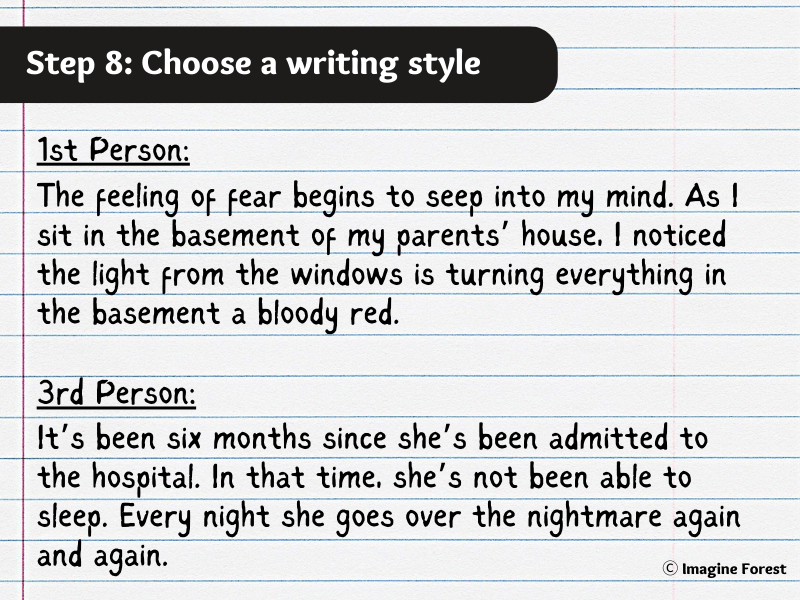
Step 9: Write the first draft
Finally, it’s time to start writing your story! Hopefully, after all these steps, you now have a rough outline for your story. But even if you don’t, just start writing! The first draft is usually the most important one. So even if you don’t have a complete outline, get started on your story. Just start writing and don’t worry about anything else! You might also want to read this post on how to outline a book for more guidance.
While writing your draft, you’ll want to keep these things in mind:
- Make sure your story is believable to a certain extent. Of course, you might think that vampires aren’t real – But make them real for your readers! This is the most important thing. If your story is impossible or unbelievable, then no one will want to read it.
- Avoid using clichés. These are words or phrases that are overused in stories and don’t really add anything to your story.
- Use active voice instead of passive voice. Passive voice is when a sentence starts with “someone” or “something”. Active voice is when the sentence starts with “I” or “we”.
- Use short sentences and paragraphs. Long sentences make it difficult to read, and paragraphs look heavy.
- If you’re struggling to get anything written down, then start with the easiest or shortest scenes first. You can always come back to the more complicated areas of your story later when you’re ready.
And finally, have fun with it! Writing is supposed to be a fun hobby, so don’t take yourself too seriously!
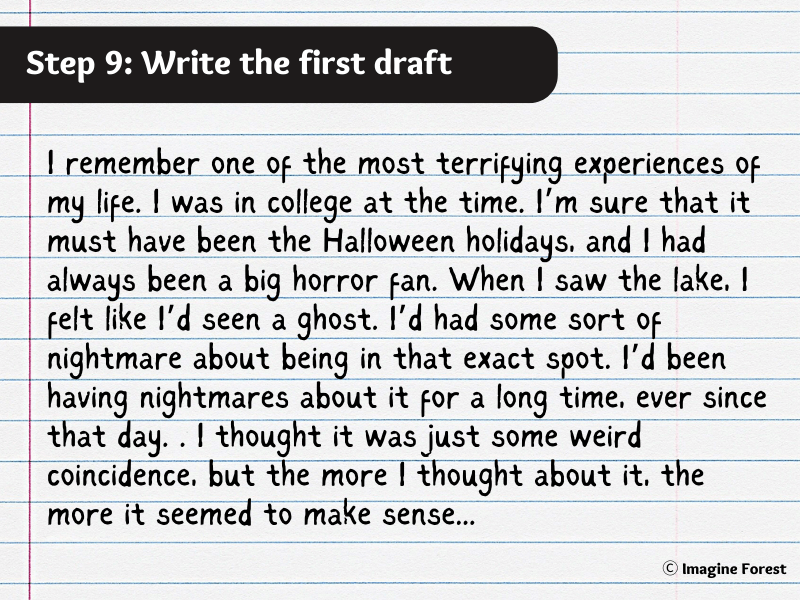
Step 10: Edit and review your draft
The hard part is done, now you’re ready to start editing your story! Start by reading the story to yourself a couple of times. Each time you read your story highlight areas that you are unsure of, or would like to improve. At the same time look out for spelling mistakes, grammatical errors, and sentences that sound a bit off. Once you’re done with this review, you can go back and make the relevant edits to your story.
Next, you’ll want to gather some feedback. This is where you’ll want to have a second or third person read your story. It’s not a good idea to let one person read your draft, as they’ll be biased towards what they like. So get a few different people to read your story, and make sure they have a different perspective. They can be family members, teachers, or even a friend that’s not familiar with your writing style.
When asking for feedback, you can ask the following questions:
- What are the most important parts of the story?
- Are there any parts of the story that don’t make sense or are confusing?
- What did you like most about the story?
- Can you think of anything that could be improved?
- Did you like the main character?
Once you have the feedback, you can go back and make the changes. It’s important to make the edits, but don’t obsess over it. In the end, you want to make the story the best that it can be. And by doing this, you’ll be on your way to writing a great horror story!
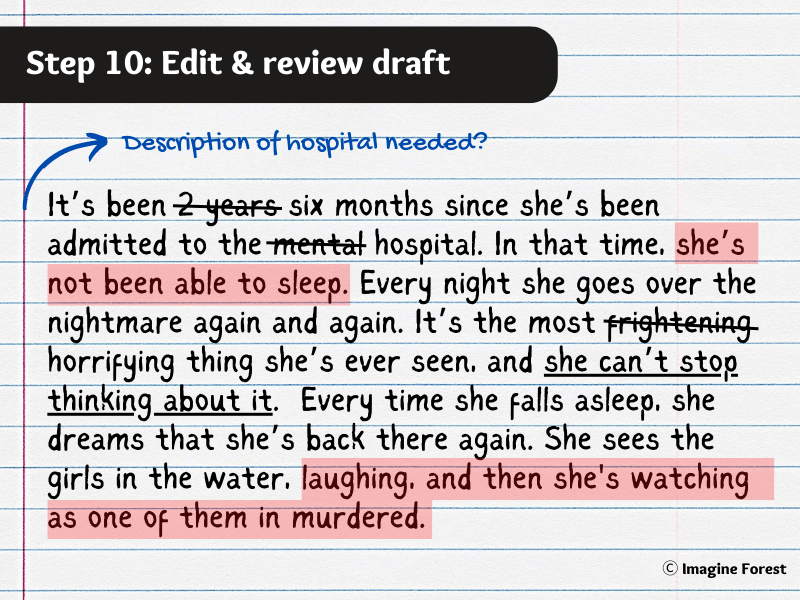
Step 11: Choose a chilling book title
It’s time to choose a book title. This is a very important part of a horror story. Not only does a good title help to give your story an identity, but it also helps to tell the reader what kind of story they’re about to read. The title should have a great hook. It should be intriguing and a little bit scary. If you’re struggling to think of a great book title, then you can try to think about what you’d like to read. Would you like to read a book that scares you? Or would you rather read a book that’s about someone’s struggles?
If we look at some popular horror book titles, we can see that most of them are quite descriptive:
- The Woman in Black
- Bram Stoker’s Dracula
- It
- The Haunting of Aveline Jones
- The Haunting of Hill House
- The Graveyard Book
- Funnybones
- Ghost Boys
Essentially, they either describe the antagonist of the story or the main setting in the story. Based on this try to summarise your horror story in as little as 3 to 5 words. Think about the main setting or the main villain/monster of your tale and come up with some book title ideas. If you’re still struggling, check out this horror book title generator for some more interesting ideas.
An important thing to note here is that you should make sure that your book title is not already in use or taken by another author. Try doing a quick Google search or a search on Amazon to see if your title is available for the taking!
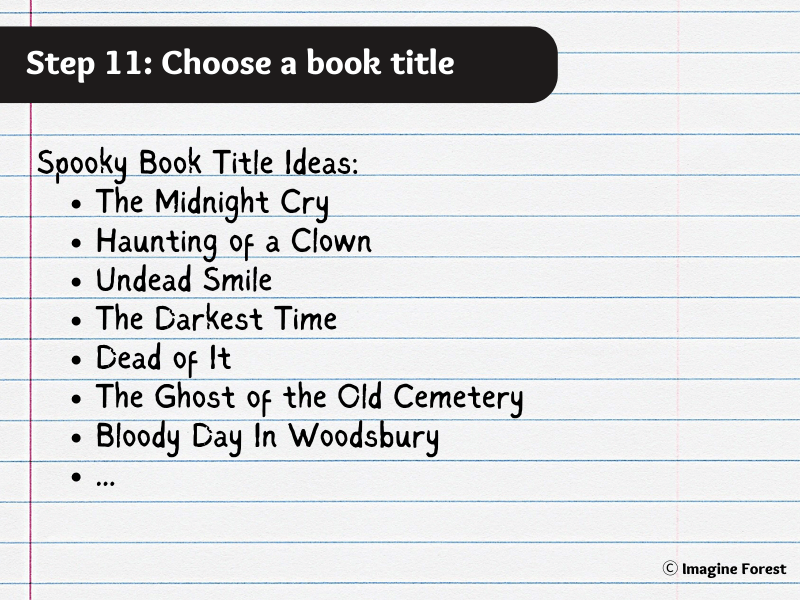
Step 12: Publish the book
Your book is now finished! You’ve written the first draft, edited it, gathered feedback, and now it’s time to publish it! There are many ways to publish your book. The most popular method is to publish it on Amazon as a self-published author. You can also work with a professional publisher to get your book to market.
Remember that if you’re a new writer, then it’s not a good idea to start by publishing your book on Amazon. It’s better to start slow and work your way up. You don’t want to rush your writing and end up with a book full of mistakes! Start by publishing your book using a free tool like the Imagine Forest story creator, then later work your way up to publishing on Amazon.
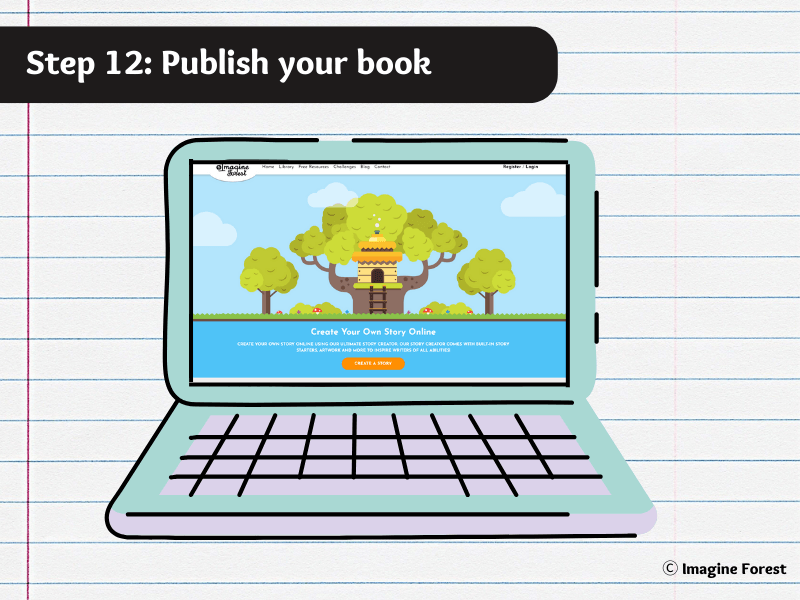
That’s it! Now you should be ready to write your own horror story! Give it a go and see what you can come up with!
Frequently Asked Questions
How do you start a horror story?
There are a number of ways to start writing a horror story:
- Focus on your own fears. Start by listing your fears and develop your story idea from there.
- Introduce the character. You can describe your main character in the first few scenes. Make them as normal, and relatable as possible
- Describe a setting. If the setting is key to your story, then describe every inch of it. Make your readers feel like they are right there with you.
- Start with some action. This could be a bloody murder, someone screaming and running or anything else that makes the reader feel uncomfortable.
- Picture a harmonious place. You can describe a calm and happy place. Somewhere taken from a romantic rom-com type story or a happy family movie, which all suddenly changes.
- Start at the end. Rewrite your potential ending as the beginning, and then work your way backwards.
What are the 5 elements of a horror story?
The 5 elements of horror include Character, Setting, Action, Horror, and Resolution. All these elements are crucial in developing a gruesome horror story.
See our guide on the 5 elements of story-telling for more information.
What makes a good horror story?
A good horror story has fear at its core. The reader must be scared as they read the story. If not then you missed something important in your novel. A good horror story must be scary, but it should also have an element of realism to it. The story should include relatable main characters, a scary antagonist, a creepy setting and of course a shocking reveal at the end.
How do you write in creepy writing?
Your first step is to try to think about the creepiness of the setting. Is it a dark and scary place? Is it full of secrets? If it is, then you have a good place to start. Try to be very detailed, and specific when describing the setting. Describe the blood on the wall as it drips down, or the lock on the door that won’t turn. Make the reader feel as if they are right there. Use descriptive words and metaphors to bring your gory details to life.
How do I make my character terrifying?
To make your character as terrifying as possible, you could try the following techniques:
- Make your character an outcast. They don’t fit in with the main group of characters and can’t be trusted.
- Give them a story to tell. A dark and bloody past.
- Make them a loner. They can’t trust anyone else and have no friends.
- Make them a survivor. The main character of your story has been through a lot and can’t be stopped.
- Give the character an important title. Someone who is important in a society that has deadly plans. You can’t trust them, but have no choice but to follow their rules.
Did you find this guide on how to write a horror story useful? Let us know in the comments below.


Marty the wizard is the master of Imagine Forest. When he's not reading a ton of books or writing some of his own tales, he loves to be surrounded by the magical creatures that live in Imagine Forest. While living in his tree house he has devoted his time to helping children around the world with their writing skills and creativity.